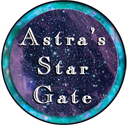Commercial Launch Vehicle Developers
Commercial space development has been with us since the 1960's, but recent years have seen the commercial sector grow. New companies are launching rockets and a new generation of space enthusiasts has been born. Please be advised that this page is not complete and will be updated with further information. Please send your comments and suggestions to the Gatekeeper using our contact page.
Space Exploration Technologies Corp. aka SpaceX

SpaceX was founded in in 2002 by Elon Musk. Its headquarters were originally located in Hawthorne, CA, but it was moved to Texas at the end of 2020. SpaceX developed the first privately funded liquid-fueled rocket to reach orbit, the Falcon 1 that was also the first privately developed liquid-fueled rocket to put a commercial satellite in orbit, launching RazakSAT on a Falcon 1 on July 14, 2009. SpaceX also made the first commercial launch of a satellite into geosynchronous orbit.
Under NASA's Commercial Orbital Transportation Services (COTS) program, SpaceX developed the Dragon Cargo vehicle. The first demonstration flight of Dragon was launched on December 8, 2010. Before the test could be launched SpaceX had to get a license for spacecraft re-entry from the Federal Aviation Administration's (FAA) through the Office of Commercial Space Transportation for the flight. It was the first vehicle re-entry license issued to a private enterprise! By the end of 2020, SpaceX had launched 22 resupply missions to the International Space Station (ISS).
But Elon Musk and SpaceX didn't stop with Cargo flights. Working with NASA, the Dragon was improved to launch human beings to the ISS. In May of 2020, SpaceX launched Crew Dragon from Kennedy Space Center in Florida on May 30, 2020, the first launch of human astronauts since the Shuttle program ended in 2011. NASA astronauts Bob Behnken and Doug Hurley flew on the Crew Dragon spacecraft to the ISS and returned safely on Earth to August 2, 2020 for Crew Dragon's second demonstration mission. SpaceX launched NASA astronauts Victor Glover, Michael Hopkins, Shannon Walker and Japan Aerospace Exploration Agency astronaut Soichi Noguchi to the ISS on November 14, 2020, bringing the crew total for Expedition #64 to 7 astronauts, another space first!
- - Read more about the SpaceX on Astra's SpaceX Page

Aerojet Rocketdyne
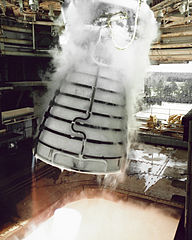
Aerojet Rocketdyne was formed in 2013 when Aerojet and Pratt & Whitney Rocketdyne merged. The company is perhaps best known for the RS-25 engine, as known as the Space Shuttle main engine (SSME). The company is headquartered in Sacramento, CA. It operates at 13 different location in the U.S. including Washington D.C., Huntsville, AL, and Orlando, FL, just to mention a few.
Aerojet Rocketdyne is an international space developer that manufactures advanced propulsion systems for customers including NASA, the U.S. Department of Defense and other government and private customers. Aerojet Rocketdyne is the prime contractor to the US Department of Energy for the Multi-mission Radioisotope Thermoelectric Generator (MMRTG). Aerojet Rocketdyne's MMRTG is currently powering the Mars Curiosity Rover and Perseverance Rover.
In February of 2021, Aerojet Rocketdyne was awarded a contract for two MMRTG's by the U.S. Department of Energy (DOE) that will be used in future planetary missions.

Blue Origin, LLC
Blue Origin was founded in 2000 by Jeff Bezos, and is headquartered in Kent, Washington. Their stated goal is to make access to space cheaper and more reliable through reusable launch vehicles.
Sub-orbital spaceflight - the New Shepard
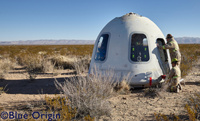
The New Shepard rocket is named after Alan Shepard, the first American astronaut to go to space. New Shepard is a reusable suborbital rocket system that can take astronauts and research payloads past the Kármán line considered the boundary between space and Earth.) The final goal is to take humans to space as a commercial venture as well as for professional astronauts. The spacecraft allows an 11-minute flight powered by the New Shepard rocket to provide passengers a view from space. As of July, 2021, the New Shepard has been launched 24 times. On July 20, the New Shepard carried its first human payload.
The image here shows Blue Origin workers recovering the New Shepard-10 after landing on January 23, 2019. Note the large windows for astronauts and passengers that will provide full view for 8 minutes during the flight of the New Shepard. Image credit Blue Origin.
The New Sheppard system includes a booster and a crew capsule. The booster is powered by a Blue Origin 3 engine (BE-3) that returns to Earth and is reusable. It is the first suborbital booster to make a vertical landing. The crew capsule returns to Earth separately, deploying parachutes and making a relatively soft landing on the surface.
In September 2022, an uncrewed mission of the New Shepard had an anomaly due to a failure of the BE-3PM main engine. The launch escape system triggered and the capsule landed safely. The remaining New Shepard launch vehicles were grounded while the FAA investigated the incident. Blue Origin found the cause of the anomaly to be failure of an engine nozzle that triggered the capsule's emergency escape system to activate. The system did its job as expected, although it would have been a harrowing ride for anyone on the vessel. New Shepard flights resumed on December 19, 2023 with the NS-24 flight. The return to flight included 33 payloads and 38,000 postcards as the Postcards to Space program.

⋆ ⋆ ⋆
On July 1, 2021, Blue Origin announced that Wally Funk, an 82-year old experienced pilot and retired FAA investigator, will have a seat on the launch of the New Shepard rocket on July 20 as an honored guest. The successful flight also included Jeff Bezos, his brother Mark Bezos, and 18-year-old Oliver Daemen.
Read the Blue Origin press release
Read starwoman Wally Funk's biography on Astra's Women in Space page
Orbital spaceflight - New Glenn
The New Glenn rocket is named after John Glenn the first American astronaut to reach orbit. The New Glenn is a heavy-lift launch vehicle. It is planned that the New Glenn will be capable of carrying people and payloads to Earth orbit and beyond. The goal is to reuse the first stage of the New Glenn rocket 25 times. The rocket will be 70 feet (21.9 meters) high with a fairing diameter of 23 feet (7 meters). It uses seven BE-4 engines on its first stage and two BE-3U engines on the second stage. Blue Origin will recover the booster on a floating offshore platform. Full re-usability is the company's goal.
NASA has placed the Escape and Plasma Acceleration and Dynamics Explorers (ESCAPADE) mission on New Glenn's maiden flight. ESCAPADE mission consists of two small probes that will study Mars’ magnetosphere. The New Glenn rocket will place the twin spacecraft into low earth orbit and the spacecraft will move into Mars transfer orbit using their own engines.
- - Find out more about Mars ESCAPADE mission on Astra's Mars Exploration page
Blue Origin has been working on many other projects, including Blue Ring, a spacecraft that will provide in-space logistics and delivery for commercial and government customers and Blue Alchemist, a NASA Tipping Point partnership to produce solar cells from lunar regolith. The process being developed for Blue Alchemist will produce oxygen as a by product that has applications for life support and propulsion.
⋆ ⋆ ⋆
Club for the Future
Blue Origin's Club for the Future was founded in 2019. Its purpose is to inspire students to pursue careers in STEM with emphasis on space development and exploration. One program is Postcards to Space where students create a postcard, send it to Blue Origin and it is launched on the New Shepard. As of April 2021, over 25,000 have been received and sent into space on the New Shepard. Blue Origin also collaborates with other organizations that promote space education. The club also has a facebook page.
⋆ ⋆ ⋆
The National Team
Blue Origin leads the National Team consisting of aerospace contractors including Lockheed Martin, Draper, Boeing, Astrobotic, and Honeybee Robotics. The National Team failed to be selected by NASA under the Artemis Human Landers program, but was awarded a contract on May 19, 2023 under the NextSTEP-2 Appendix P Sustaining Lunar Development (SLD). The National Team will develop a lunar lander that can make a precision landing anywhere on the Moon’s surface for the Artemis-5 mission. the contract also includes the development of a cislunar transporter. These vehicles are to be powered by liquid hydrogen (LH2) and liquid oxygen (LOX) also known as LOX-LH2.

The Boeing Company
Boeing was founded by William Boeing in 1916. Boeing headquarters is in Chicago, IL, and it is perhaps the largest multi-national corporation on this "commercial" page. Today Boeing makes airplanes, rotorcraft, rockets, satellites, telecommunications equipment, and missiles. At Astra's our primary interest is in space-related products. Boeing is part of NASA's Artemis lunar exploration program as they are building the heavy-lift rocket that will take astronauts to the Moon.
The Boeing Model was the first Boeing product - - a single-engine biplane aircraft. The company expanded their business during two world wars and was important in the early history of air flight. Boeing aerospace history is long and involved. Through the years they purchased many aerospace companies, among them McDonnell-Douglas and Hughes Space and Communications.
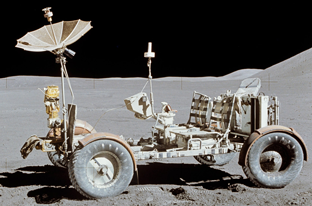
We give only a few of Boeing's accomplishments during its long history. Boeing built the Lunar Roving Vehicle (LRV) that was used on the Moon. Commonly called the "moon buggy", there were three vehicles sent to the moon in the Apollo program (missions 15, 16, and 17). A fourth LRV was built but never launched. The moon buggy's greatly increased the amount of time and distance the astronauts could spend exploring the surface. The LRV remain on the Moon today.
Boeing also built the Mariner 10 spacecraft that successfully studied Venus and Mercury. Mariner 10 was the first US spacecraft to use an interplanetary gravitational slingshot maneuver. The probe used the planet Venus to change its flight path and take it into Mercury's orbit in 1974. Mariner 10 and MESSENGER (MErcury Surface, Space ENvironment, GEochemistry, and Ranging) are the only spacecraft to visit Mercury. MESSENGER arrived at Mercury in 2011.
Space Launch System (SLS)
Boeing is the prime contractor for the Space Launch System (SLS), the giant rocket that will lift the Artemis Mission off planet Earth. The Boeing-built core stage for the Artemis I mission is completed and being tested at NASA’s Stennis Space Center in Hancock County, MS. Boeing will continue building the core stages for Artemis II and Artemis III when the first woman and the next man touch down on the Moon.
Starliner (CST)-100
Boeing has also been building the Crew Space Transportation (CST)-100 Starliner spacecraft. NASA astronauts Butch Wilmore and Suni Williams are scheduled to fly Starliner and United Launch Alliance Atlas V rocket to the International Space Station in April 2024. They will be docked at the orbiting laboratory to evaluate the new spacecraft and its systems returning to Earth two weeks later. Read about Boeing and the Starliner spacecraft on Astra's ISS page.
SpectroLab, a Boeing Company
SpectroLab became a subsidiary of Boeing in 2000. The company was originally founded in 1956 by Alfred E. Mann. Spectrally is based in Sylmar, CA. Spectrally made the solar arrays that are currently orbiting with the International Space Station. Their XTJ Prime solar cells are used on the Starliner (CST)-100 spacecraft. In 2020, Spectrally won a contract to augment the International Space station solar array with their XTJ solar cells.
- - Read more about Spectrally on Astra's International Space Station Page

Firefly Aerospace, Inc.
Firefly is headquartered in Austin, TX. Firefly aspires to be an end-to-end space transportation company. Their work focuses on developing a family of launch vehicles and in-space vehicles, and to provide services to government and commercial customers. The company has developed its two-stage Alpha rocket, that was successfully launched in October 2022 when it became the first US commercial space company with a rocket in the 1300-kg payload lift class.
On September 14, 2023, Firefly launched the Alpha rocket on its first mission for the U.S Department of Defense and demonstrated rapid response capability. Firefly placed a spacecraft for Millennium Space Systems into orbit under the Victus Nox mission.
Firefly is developing its Beta rocket, now renamed as Medium Launch Vehicle, or MLV in partnership with Northrop Grumman. It will carry more than 16,000 kg to low Earth orbit, MLV will first launch from Virginia’s Mid-Atlantic Regional Spaceport (MARS) on Wallops Island and is designed to be compatible with additional launch ranges on the east and west coast.
Firefly is developing a Space Utility Vehicle (SUV) a solar-electric third stage spacecraft for the Alpha and the MLV launch vehicles. Now known as Elytra (firefly wings), it will provide in-space transportation, maintenance, and refueling options. Elytra has three vehicle design called Elytra Dawn, Elytra Dusk, and Elytra Dark that travel further into space to support larger, more advanced on-orbit missions. Elytra Dawn is optimized for low Earth orbit (LEO), Elytra Dusk is maneuverable for responsive on-orbit tasking and can work from LEO to geosynchronous orbit (GEO). Elytra Dark is ruggedized and can support transfers from LEO to lunar orbit and beyond.
Firefly is also developing the Blue Ghost lunar lander. The lander has entry, descent, and landing capabilities (EDL) and the ability to deliver as much as 150 km to the lunar surface. Firefly announced that it completed the landing structure for Blue Ghost in October 2023.
- - Read more about Firefly's Blue Ghost lunar lander at Astra's

Rocket Lab
The company was founded in New Zealand in 2006 by engineer Peter Beck. Its headquarters in California in the United States in 2013. The company has been very successful and has become popular for small payload launches. NASA has contracted with Rocket Lab to launch a 55-pound CubeSat as the first spacecraft to test a special lunar orbit as part of NASA’s Cislunar Autonomous Positioning System Technology Operations and Navigation Experiment (CAPSTONE). This is a trail-blazing effort that will help to test the near rectilinear halo orbit that is under consideration for the Lunar Gateway that is part of NASA’s Artemis program. CAPSTONE will help reduce risk for future spacecraft by testing navigation technologies and verifying the dynamics of the orbit.
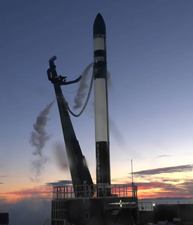
Electron is a two-stage rocket with a cluster of 9 identical engines on the first stage. The oxygen/kerosene pump fed engine, "Rutherford" is named after the New Zealand-born scientist Ernest Rutherford. The second stage utilizes a Rutherford engine configured to burn in a vacuum. Electron can also be supported with a "Kick Stage" is designed to deliver small satellites to precise and unique orbits. Electron made its first flight on May 25, 2017. It is a small rocket designed to be simple and cheap to produce, for lifting small payloads. Rocket Labs fabricates the combustion chamber, injectors, pumps, and main propellant valves using 3D printing. Rocket Lab recovered the first stage of the Electron booster during its "Return to Sender" mission that launched on November 19, 2020. The first stage returned to Earth using a parachute.
Rocket Lab has a special satellite bus named Photon. It is used to launch small payloads into Earth orbit. It reduces the development time for customers who no longer have to develop a full spacecraft. Rocket Lab announced plans to create a new satellite bus, named Photon, to launch small payloads into Earth orbit. The first operational launch for Photon will be NASA's CAPSTONE CubeSat mission.
Image courtesy Rocket Labs, their Electron rocket is carrying a batch of small satellites on a mission "Make it Rain", launching from New Zealand in 2019.
Launch Sites
Launch Complex 1 in Mahia, New Zealand is Rocket Labs' private orbital launch site. The site can accommodate 120 launches per year and can launch every 72 hours. The company also uses Launch Complex 2 at Wallops Island, VA and can support up to 12 missions per year.
Rocket Lab is developing Neutron, a medium-lift two-stage launch announced in early 2021. It is being designed to be capable of delivering a 13,000 kg payload to low Earth orbit or 1,500 kg to Mars or Venus. It will be reusable. The rocket is expected to be operational sometime in 2024. It uses LOX and liquid methane propellant on both stages. A new engine called Archimedes, will carry payloads to orbit. Seven sea-level Archimedes engines will be located on the first stage and one vacuum engine will power the second stage.

Northrop Grumman
Northrop Grumman (N-G) was founded in 1994 when Northrop Aircraft bought Grumman Aerospace. (Grumman Aerospace built the Apollo Lunar Lander.) Northrop Grumman bought Orbital ATK on June 7, 2018. The company has 4 main business sectors: Aeronautics Systems, Defense Systems, Mission Systems and Space Systems. At Astra's we are primarily interested in the Aeronautic sector of N-G.
Northrop Grumman's Aerospace Systems is headquartered in Redondo Beach, CA. N-G is the primary contractor for the James Webb Space Telescope. Northrop Grumman's Antares rocket is a two-stage vehicle (3-stage optional) that can launch payloads weighing up to 8,000 kg into low-Earth orbit. Antares is primarily used to launch vehicles into orbit under NASA's Commercial Resupply Services contract. The last launch of the Northrop Grumman’s Cygnus resupply spacecraft was on August 1, 2023 from NASA’s Wallops Flight Facility in Virginia. (NG-19 Cygnus). The NG-19 Cygnus spacecraft was named "S.S. Laurel Clark." after female astronaut who perished on the last flight of Shuttle Columbia.
Antares first stage was built in the Ukraine, causing N-G to seek a partner. The Antares 330 will have a new first stage with seven Firefly Miranda engines and use existing launch and processing facilities that supported many other NG Commercial Resupply Services (CRS) flights. Like earlier versions of Antares, the 330 will fly from Launch Pad 0A at Wallops.
Cygnus Spacecraft
The Cygnus spacecraft has two modules: the Service Module (SM) including the avionics, propulsion and power systems and the Pressurized Cargo Module (PCM) that carries the crew supplies, spares and scientific experiments. The SM is integrated and tested at Northrop Grumman's satellite manufacturing facility in Dulles, VA.

Relativity Space
Relativity Space is headquartered in Los Angeles, CA. It was founded in 2019 by Tim Ellis and Jordan Noone. Relativity is working to build a reusable rocket utilizing 3D printing for many rocket parts. They have a factory in California and test their rocket engines at NASA Stennis space center where they occupy a building. Relativity has built a "Factory of the Future" that features Stargate, the world’s largest metal 3D printer. Their patented technology makes building a rocket cheaper than conventional systems.
Relativity's first launch vehicle is an expandible. Terran 1 is a two-stage vehicle capable of lifting 1,250 kg to low earth orbit. Their rockets use Aeon engines that are 3D-printed,powered by liquid oxygen and liquid natural gas propellants. The Aeon engine has been fired over 500 times during testing. Terran 1 has 9 Aeon rockets on its first stage and 1 vacuum engine on the second stage. Terran 1 launched successfully on March 23, 2023 but did not achieve orbit. Terran 1 was retired after these failures but it was the largest 3d printed object to reach space.
Terran R is expected be the first fully reusable 3d printed rocket. The first versions of Terran R will have some parts that are not printed, but Relativity is developing a third-generation aluminum alloy that will make the whole system 3d printed. It will be lifted by 7 reusable Aeon rockets (Aeon R), and 1 Aeon vacuum engine on the second stage that will take the vehicle into orbit. It can lift payloads up to 23,500 kg to low-Earth orbit. It may be returning to an earth landing site or landing on the water. It is expected to launch in 2026.
Stoke Space
Stoke Space is headquartered in Kent, WA near Seattle. It was founded in October 2012 by former Blue Origin and SpaceX employees. Stoke is working to build a fully reusable rocket. Their facility is located in Moses Lake, Washington. They are working on fully reusable rockets. Their rocket has been named Nova.
Stoke won a $225,000 SBIR Phase I grant from the National Science Foundation helping to fund their work on an integrated propulsion solution for reusable rocket upper stages. In March 2023, Stoke was allotted Launch Complex 14 (LC-14) at Cape Canaveral Space Force Station in Florida by U.S. Space Force. NASA launched John Glenn and the Mercury-Atlas 6 mission on February 20, 1962 from LC-14. Glenn was the first American to orbit Earth. Launch Complex 13 and 15, were also allotted to other commercial space companies.
Stoke has been building test articles for their second stage that they are testing in Moses Lake. The first test article, Hopper 1, was lost during testing. On September 17, 2023, Stoke successfully tested Hopper2, it ascended to ~30 feet (9 meters), traveled horizontally and landing at the intended site. The flight lasted 15 seconds. This will be the last test of its kind because the data collected was sufficient for Stoke to move forward.
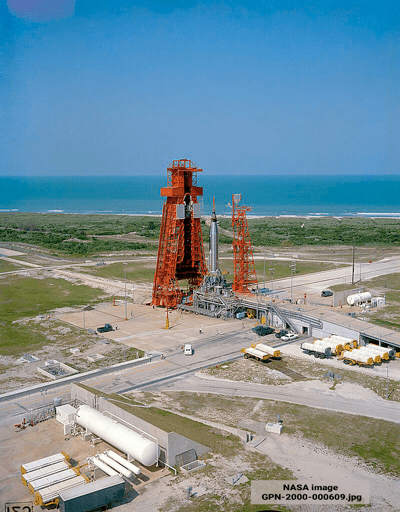
United Launch Alliance (ULA)
United Launch Alliance is a joint venture between Lockheed Martin Space and Boeing Defense, Space & Security in December 2006. ULA provides launch services using expendable launch systems Delta IV Heavy and Atlas V. As of January 2021, the Atlas V has been launched 86 times!
From their website:
Atlas V Rocket
ULA’s Atlas V rocket is a workhorse for the U.S. military, intelligence community and scientific researchers. Developed as a modular vehicle, each Atlas V is tailored to the needs of its passenger by adding as many as five side-mounted solid rocket boosters for increased lift performance and a variety of available payload fairings in various diameters and lengths to protect satellites during atmospheric ascent. The high-energy Centaur upper stage, which has been used to send spacecraft to every planet in our solar system, is incorporated into Atlas V to deliver the payloads to their intended destinations.
The Atlas V rocket has two main stages. The first stage uses a Russian manufactured RD-180 engine that burns kerosene and liquid oxygen. The upper stage is a Centaur has two Aerojet Rocketdyne RL10 engines that use liquid hydrogen and liquid oxygen. The vehicle often uses strap-on solid rocket boosters (SRBs) that are Graphite-Epoxy Motor GEM 63 SRBs. To end reliance on Russian manufactured engines, there is a limited number of flights for Atlas V that is based on current inventory.
Vulcan Centaur
The Vulcan Centaur is a 2-stage rocket developed by ULA to lift satellites to low-Earth orbit (LEO) and Geosynchronous Orbit (GEO). Vulcan is intended to be reusable and will eventually be a Evolved Expendable Launch Vehicle (EELV). The first stage is equipped with two Blue Origin BE-4 engines. It uses liquid methane propellant and liquid oxygen. Vulcan Centaur will be used with Northrop Grumman Graphite Epoxy Motor (GEM) 63XL solid rocket boosters (SRB) and can be configured to launch with 0, 2, 4, or 6 SRBs.
Vulcan uses the Centaur V for its upper stage. The upper stage uses two Aerojet Rocketdyne RL10C engines operating on liquid hydrogen and liquid oxygen. The Centaur is a rocket with a long history, originally conceived in the 1950's. This rocket was intended as a high-energy upper stage from the beginning. Through the years, there were many versions and Centaur V is an upgrade to the Common Centaur/Centaur III that is currently used on the Atlas V. ULA plans to upgrade the Centaur V with Integrated Vehicle Fluids technology that will reduce the electronics and batteries in the Advanced Cryogenic Evolved Stage (ACES). Special insulation will protect cold fuels from boiling off to increase mission duration. It will also be refuelable.
Vulcan Centaur launched on its maiden flight on January 8, 2024, at 2:18 EST from Cape Canaveral Space Force Station in Florida. The name of this flight was Cert-1. This flight carried Astrobotic's Peregrine moon lander that was to land on the Moon. Unfortunately, the spacecraft lost too much propellent and was no longer able to achieve lunar orbit. Vulcan performed flawlessly, discarding its boosters after two minutes of flight, and cut out the first-stage engine about three minutes later. The Centaur upper stage released the Peregrine lander exactly as planned. Vulcan carried 21 payloads, including 6 from NASA and 8 from other U.S. customers. The other payloads were from many different countries. The last payload delivered was the Celestis Memorial Spaceflights deep space Voyager mission, known as the Enterprise Flight after Gene Roddenberry and Majel Barrett-Roddenberry, Nichelle Nichols, and James Doohan from the "Star Trek" universe were among those whose ashes were flown destined for deep space.
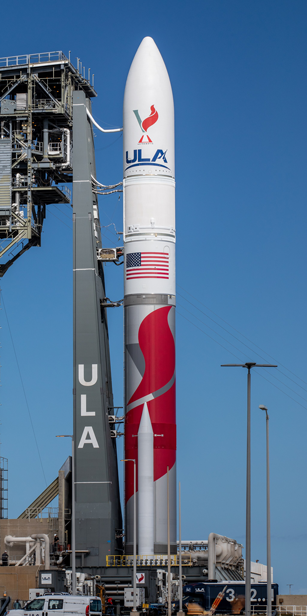
NASA Kennedy Space Center/NASA/Ben Smegelsky
Some Testing Milestones
On June 7, 2023, United Launch Alliance completed the final flight readiness test of the heavy-lift rocket at Cape Canaveral’s Space Launch Complex 41. The rocket’s two BE-4 engines fired for four seconds, then throttled up two seconds before shutting down. The entire test lasted for about six seconds. This successful static fire was good news for ULA.
On October 4, 2021, the flight-configuration Vulcan core stage, named the Pathfinder Tanking Test (PTT) booster, was tested at the Spaceflight Processing Operations Center (SPOC) at Cape Kennedy. It was transported 2.7 miles (4.3 km) to Space Launch Complex (SLC)-41 aboard the Vulcan Launch Platform (VLP). The test flight included mounting the rocket to the launch pad and fueling. A mock countdown went all the way day to T-0, before the test ended.
+ Check out ULA's Countdown to Vulcan
#AstrasStargate #ImaRocketFan
Yuzhnoye Design Office
Located in Ukraine, the Yuzhnoye State Design Office was founded in 1954. It was once part of a design department of the Yuzhnoye Machine-Building Plant. Yuzhnoye developed the Kosmos rocket. The Kosmos vehicles were launched from Kapustin Yar and Plesetsk launch sites 165 times completing 143 successful missions. Yuzhnoye built other launch vehicles, notably the Kosmos-2, Cyclone-2. Zenit-2.
Work on spacecraft design began at Yuzhnoye in 1960 when space exploration was a new field. Their successful space missions made important contributions to the study of Earth’s atmosphere, clouds, and its surface. The office was also involved in the Interkosmos program fostering international cooperation in space exploration. The design office supported astronomical research as well as defense.

Lunar, Planetary, and Space Exploration Commercial Developers
The exploration of space has gone on since humans looked up into the sky and wondered. Space exploration took off after the launch of Sputnik and these vendors have been supporting the adventure. Of course, lunar exploration began in the 1960's, but NASA has renewed plans to go back to the Moon and commercial development has bloomed, especially in the US. Some of the companies above also belong in this section!
Please send your comments and suggestions to the Gatekeeper using our contact page.
Collins Aerospace
Headquartered in Charlotte, NC, Collins Aerospace was founded in November 2018 from a merger of Rockwell Collins and UTC Aerospace Systems. Owned by Raytheon Technologies, Collins Aerospace is a large aerospace and military contractor. Focusing on Collins space exploration activities, the company is developing space suits, environmental controls and life support systems (ECLSS), power management and distribution systems, and other technologies. Recently Collins has been awarded a part of the Explorations Extravehicular Activity (xEVAS) contract that give Collins Aerospace and Axiom Space a part of a $3.5 billion contract that is based on the spacesuits they provide, lasting through 2034.
Dynetics
Dynetics (a subsidiary of Leidos) was founded in 1974 is based in Huntsville, AL. Dynetics is supporting the Artemis lunar mission with a Universal Stage Adapter (USA) for NASA’s Space Launch System (SLS).
Dynetics was developing lunar lander Autonomous Logistics Platform for All-Moon Cargo Access (ALPACA) with ascent and descent capabilities that would have launched on the ULA Vulcan launch system. Dynetics assembled a team composed: Sierra Nevada Corp., Oceaneering, Paragon Space Dev. Corp., and Maxar Technologies to on the ALPACA. The ALPACA was not chosen to continue in the competition that was eventually won by SpaceX.
Dynetics is now working with the Defense Advanced Research Projects Agency's (DARPA) on the Air Combat Evolution (ACE).
VAST
Vast or Vast Space was founded in 2021 by Jed McCalebis and is headquartered in Long Beach, California. Vast wants to create an artificial gravity space station. With the purchase of the aerospace firm, Launcher, Vast gained the Orbiter and the Light launch vehicle. Orbiter is a satellite transfer vehicle and platform.
Astrolab
Venturi Astrolab, Inc. (Astrolab) is headquartered in Hawthorne, California. This aerospace startup is working with Venturi on FLEX, a new lunar robot that can deliver payloads to the lunar surface and also provide an unpressurized rover for two astronauts enabling mobility on the lunar surface.
Flexible Logistics and Exploration (FLEX) Rover
Astrolab's FLEX rover is intended to support human operations and lunar exploration to help build a sustained human presence on the Moon. It will be constructed to deliver payloads from under the rover's chassis as well as on the top of the vehicle. FLEX will also have a robotic arm that can lift up to ~25 kilograms. When crossing the lunar surface, it will be able to raise its body to avoid obstructions.
On March 31, 2023, Astrolab announced that the FLEX lunar rover will be launched on the SpaceX's Lunar Starship on an upcoming mission to the Moon.
Lockheed-Martin
Lockheed Martin Corporation is an American aerospace and defense company formed by the merger of Lockheed Corporation with Martin Marietta in March 1995. Lockheed Martin is also a major defense contractor and has built advanced satellites that are in use by the military and civilians. Lockheed-Martin has contributed to Mars missions with orbiters and landers, including the ill-fated Mars Climate Orbiter. Its headquarters is in North Bethesda, MD. NASA selected Lockheed Martin to provide payload delivery services under the Commercial Lunar Payload Services (CLPS) contract.
Lockheed Martin is a member of the Blue Origin "National Team" along with Northrop Grumman and Draper developing a human lunar lander for NASA to incorporate into NASA’s Artemis Moon mission. If selected it will take the US astronauts back to the lunar surface.
McCandless Lunar Lander
Lockheed Martin's McCandless Lunar lander is named in honor of astronaut Bruce McCandless II who passed away in 2019. McCandless is well known for flying the Manned Maneuvering Unit (MMU). L-M is building the lander under the CLPS program based on their Mars InSight lander design. It will be capable of transporting large payloads to the surface of the Moon. These may be scientific instruments, deployable rovers, or even sample return vehicles.
Honeybee Robotics
Honeybee was founded in 1983 by Steve Gorevan and Chris Chapman. With headquarters based in New York (Brooklyn Navy Yard), the company also has facilities in Longmont, CO and Pasadena, CA. In 2015, Honeybee Robotics established the Santoro Scholarship fund to support engineering students interested in robotics. The scholarship is in honor of electrical engineer Christopher Santoro, a valued employee who began working at Honeybee in 2005 as an intern and passed away in 2015.
Honeybee Robotics has supported many of NASA’s Mars exploration missions building systems for drilling, coring, and taking samples on Mars missions. Honeybee supported the Mars Exploration Rovers with its Rock Abrasion Tool, and Phoenix Mars Lander mission with the Icy Soil Acquisition Device, and Curiosity Rover with the Dust Removal Tool. Honeybee is also interested in asteroid mining. They designed an Asteroid Water Extractor to gather icy soil samples and extract the water.
Trans Astronautical Corporation aka TransAstra
TransAstra was founded in 2015. They desire to build the "transcontinental railroad of space" to open the solar system for exploration. They envision a future where humans are homesteading the solar system and living off the resources of the asteroids.
TransAstra has plans for asteroid mining. They are developing a family of spacecraft they call APIS (Asteroid Provided In-situ Supplies). The smallest is named the Mini Bee - - a technology demonstration spacecraft. The Honey Bee that will be capable of capturing a 10m asteroid and mining its resources. The Queen Bee that will be capable of capturing a 40m asteroid. These vehicles will use an asteroid containment system similar to the one they proposed for the original Asteroid Redirect Mission. An orbital transfer vehicle called the Worker Bee, intended to transport payloads to high Earth orbits and beyond.

Astrobotic Technology, Inc.
Astrobotic was founded in 2007 as a commercial space development company. From the start, they planned to land their own rover on the Moon. Their lunar lander, Peregrine, will deliver payloads to the Moon for a variety of customers. The Astrobotic Mission Control Center (AMCC) in Pittsburgh, PA, will be used for Peregrine lunar cargo missions. Peregrine’s guidance and navigation system uses recently developed algorithms for navigation. It uses off-the-shelf sensors to provide reliable flight and lunar orbit. Astrobotic’s own Terrain Relative Navigation (TRN) will be used during descent and landing. Scanning Light Detection and Ranging (LiDAR) may also be used to detect and avoid slopes, rocks, craters, and other hazards during landing.
Peregrine can deliver payloads (up to 90 kg) to lunar orbit or to the lunar surface. Peregrine can arrive at three distinct lunar orbits. The orbital inclination is determined by the landing site. Peregrine's first landing, Mission One will land near Gruithuisen Domes on the northeast edge of Oceanus Procellarum, or Ocean of Storms, at 36.3° N, 319.8° E. Astrobotic will plan missions to maximize payload operation time on the lunar surface based on landing site. For Mission One, Peregrine will land 55-110 hours after sunrise. A lunar day (from local sunrise to sunset on the Moon) is equivalent to 354 hours, or approximately 14 Earth days. At mid-latitudes, Peregrine operates for 192 hours, or 8 Earth days after landing. Polar missions may be able to operate for longer than a single lunar day due to lighting conditions.
Peregrine lander was launched on January 8, 2024 on ULA's Vulcan Centaur. After being released in the proper orbit, Peregrine lost propellent when a valve stuck open after it made its first orbiting maneuver. The spacecraft cannot reach or land on the Moon.
In April 20, 2022, Astrobotic unveiled the flight model of its Peregrine lunar lander at their headquarters in Pittsburgh, PA. This is the model for the spacecraft that will launch to the Moon under the Commercial Lunar Payload Services (CLPS) program. The lander is on NASA's flight schedule for 2023 to be launched on the United Launch Alliance (ULA) Vulcan Centaur rocket.
Astrobotic purchased Masten Space Systems in September 2022. Astrobotic retained many Masten employees as well as Masten's suborbital launch vehicles and propulsion test centers. Astrobotic will keep suborbital flight operations at Masten’s test sites at Mojave, California. The company plans to continue to be a key testing site for hot fire rocket tests for commercial developers.
- - Read more about the Astrobotic on Astra's Lunar Exploration Page
Masten Space Systems
Masten Space Systems was founded in 2004 by David Masten. Company headquarters is in Mojave, CA. Their goal is to tear down the barriers to space exploration, build partnerships, and develop rapidly reusable spacecraft. Masten filed for bankruptcy in July 2022 and was bought by Astrobotic. Today, Masten is now Astrobotic’s Propulsion and Test department. The new website still contains information about the projects given below.
Masten is currently developing the Machete engine for XL-1T and XL-1 landers. Machete is a hypergolic engine that uses Masten's proprietary propellants, MXP-351.
In addition to the XL-1 lander, Masten had several projects under development. XEUS is a vertical-landing, vertical-takeoff lunar lander demonstrator being developed by a partnership of Masten Space Systems and United Launch Alliance (ULA). Xeus has been shelved, but it uses a Centaur upper stage (from United Launch Alliance). Completed Xeus spacecraft can deliver up to 10 tons of payload on the Moon. This system would work with the ACES vehicle discussed above. Masten has a partnership with Penn State developing Metal Oxidation Warming Systems (MOWS), a solution systems to help spacecraft survive the lunar night and operate in shadowed lunar regions. The Xogdor vehicle is another concept vehicle that can fly up to 78 km.
Masten Space Systems also competed in public–private partnership between Northrop Grumman, NASA and XPRIZE, the Lunar Lander Challenge X Prize for its lunar lander, Xombie that won the level one 2nd prize of $150,000. Another Masten vehicle Xoie (pronounced Zoey) won the level two 1st prize of $1 million in November 2009.


Intuitive Machines, llc.
Intuitive Machines was founded in 2013 and has its headquarters in Houston, Texas. Intuitive Machines won a NASA contract under Commercial Lunar Payload Services program (CLPS) to deliver scientific instruments to the Moon using their robotic spacecraft, the Nova-C. They have been tasked to deliver 2 missions to the lunar surface, The first mission is scheduled for October 2021 and the second IM-2 is a polar mission scheduled to launch sometime in 2022. Both scheduled missions will launch on SpaceX's Falcon 9 rocket.
- - Read more about the Intuitive Machines Nova-C on Astra's Lunar Exploration Page
Intuitive Machines is also working on the Universal Reentry Vehicle (URV) system that can be used to return payloads from low Earth orbit or the Moon. The URV may someday be used to enter Mars' atmosphere. This vehicle will represent an advancement in precision Entry, Descent and Landing (EDL) technology.
Nanoracks, llc.
Nanoracks's HQ is in Houston, Texas with additional offices in Washington, D.C., Abu Dhabi in United Arab Emirates (UAE), and Turin, Italy. Nanoracks was founded in 2009 by Jeffrey Manber and Charles Miller to provide commercial hardware and services for the U.S. National Laboratory on board the International Space Station. Nanoracks has flown more than 1,000 projects to the space station from more than 30 nations. In 2019, Nanoracks opened its UAE space research facility because of its partnership with the United Arab Emirates to advance knowledge and technology for food produced in space and in extreme climates on Earth.
Nanoracks has deployed small CubeSats into orbit from the ISS through the Nanoracks CubeSat Deployer via the airlock in the Japanese Kibō module. The expertise gained from launching those small satellites will be applied to the Nanoracks' Bishop airlock installed in December 2020.
Nanoracks has 4 platforms to help microgravity researchers succeed on the ISS. Nanoracks Mainframe (Nanode) is a payload rack system that transports, accommodates up to up to 12 Nanolab Modules. The Nanoracks Nanode interfaces between Nanolab Modules and the ISS. This provides mounting points and electrical connections for power, data, and communication. Nanoracks Plate Reader-2 is a Molecular Devices SpectraMax M5 modified for space flight and the microgravity environment. This is a spectrophotometer that analyzes samples by shining light (200-1000 nm) on the samples inside a microplate. It can operate in absorbance, fluorescence intensity, or fluorescence polarization modes. Nanoracks Mixture Enclosure Tubes (Mixstix) hold up to 24 mixing sticks. These may be analyzed on the ISS, or returned to Earth. Nanoracks Black Box is a platform or rack system was designed to protect ISS astronauts from materials or investigations that might be too risky for open exposure.
In 2017, the Company announced their Nanoracks Space Outpost Program. This is intended to reuse and repurpose the upper stages of launch vehicles normally discarded in space and converting them into commercial habitats. They may be both human crewed or robotic and can be located throughout the solar system.
Mars Demo-1 (OMD-1) is a Nanoracks' first mission in the Outpost program scheduled to fly mid-2021 on a SpaceX Rideshare mission.
- - Read more about Nanoracks on Astra's International Space Station page
Maxar Technologies
Maxar Technologies was founded in 1969 by John MacDonald and Vern Dettwiler known as MacDonald, Dettwiler and Associates (MDA). Its headquarters is in Westminster, CO. The organization has a complex and diverse history. It has relevance in the space industry today as a holding company for Space Systems Loral with headquarters in Palo Alto, CA; Digital Globe with headquarters in Westminster, CO and Radiant Solutions with headquarters in Herndon, VA. Its primary industry is satellites, satellite imaging, data modeling for satellite data, and satellite building and design.
Maxar has contributed to five NASA missions on Mars and provided some of the technologies that were sent to Mars in 2020 on Perseverance Rover. Maxar provided the Sample Handling Assembly (SHA) robotic arm that takes the sample and puts it into storage inside the rover. In the next step the sample is measured and secured. Maxar built Perseverance’s camera focus system, part of the SHERLOC and WATSON system mounted on the turret , which will support this mission by enabling the rover to identify promising samples on the surface of Mars.
Read more about Perseverance Rover at Astra's

Virgin Galactic
Virgin Galactic was founded in 2004 by Sir Richard Branson, a British entrepreneur and Burt Rutan to build commercial spaceships and launch vehicles that were aircraft, not rockets, for space travel. Headquarters are located in Mojave, CA. Unfortunately, Virgin Orbit, a subsidiary of Virgin Galactic has recently filed for bankruptcy after the failure of its first European launch on January 9, 2023. The mission was lost with 9 commercial payloads onboard.
Virgin Galactic's SpaceshipOne was funded by Paul Allen and designed by Burt Rutan as a venture to take paying passengers into suborbital space. Tickets would be available to the public priced at $200,000 using the Scaled Composites White Knight Two, a cargo aircraft. The first White Knight Two was named VMS Eve after Richard Branson's mother Eve. Its maiden voyage was on December 21, 2008.
When SpaceShipOne takes off from the ground, it is attached to White Knight and under its power. The combination of SpaceShipOne and White Knight can take off, land, and fly under jet power. When launched, the combined craft flies to an altitude of ~14 km (8.7 mi). SpaceShipOne is then dropped or released, and briefly glides until the rocket is ignited otherwise it can glide to the ground. When the rocket engine is ignited, SpaceShipOne can make a 65-degree climb. It can allow crew members to float in "zero" gravity and then it may also be possible to conduct microgravity research. SpaceShipOne is similar to the X-15 vehicle concept. SpaceShipOne was built to compete for the international Ansari X Prize, the race to launch the first privately built spacecraft. In October 2004, it won $10 million.
Manufactured by Virgin Galactic's The Spaceship Company, SpaceShipTwo was first presented on December 7, 2009 at the Mojave Air and Space Port in California. SpaceShipTwo is launched as SpaceShipOne was described above. The company planed to operate a fleet of 5 SpaceShipTwo spaceplanes to serve as a private passenger-carrying service, with a suborbital flight costing $250,000.
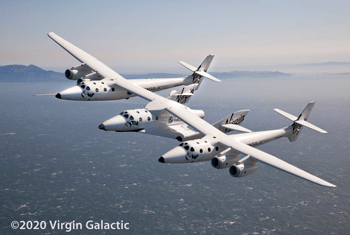
Unfortunately, the first SpaceShipTwo broke up in flight and crashed in the Mojave desert. A pilot named Michael Alsbury was killed and another severely injured due to parachuting from the craft. The second SpaceShipTwo spacecraft was unveiled in February 2016. Its first flight to space (above 50 miles altitude) took place in December 2018.
SpaceShipTwo needs 2 pilots and can carry six six passengers. Its apogee is ~110 km (68 mi) that is 10 km (6.2 mi) higher than the Kármán line. SpaceShipTwo will reach 4,200 km/h (2,600 mph), on a single rocket engine — the RocketMotorTwo. It launches from White Knight Two at an altitude of 15,000 metres (50,000 ft.). After 70 seconds, the rocket engine shuts down and the spacecraft coasts to its peak altitude. Virgin Galactic launches from their facilities at Spaceport America in New Mexico.
Unity 22 mission
On July 11, 2021, Virgin Galactic's fourth crewed mission carried more than just the pilots: Dave Mackay and Michael Masucci who control the vehicle's flight and re-entry. The company's founder Richard Branson boarded the VSS Unity to take a 90 minute flight to the edge of space. This flight also included mission specialists Beth Moses, astronaut trainer; Virgin Galactic's engineer Colin Bennett; and Sirisha Bandla, a vice president of Virgin Galactic.
Galactic 01 (was Unity 23 mission)
Virgin Galactic's fifth crewed mission was the first commercial flight for Virgin Galactic, that launched on June 29, 2023. The pilots were Michael Masucci and Nicola Pecile who controlled the vehicle's flight and re-entry. The next 90-minute flight to the edge of space includes Colin Bennett, astronaut trainer; British, Walter Villadei, mission lead, and Angelo Landolfi; and the National Research Council of Italy's Pantaleone Carlucci, aerospace engineer.
This was a research mission, to evaluate the effects of the "transitional phase" from gravity to zero G on the human body. Crew members wore sensors to measure physiological activity. Villadei wore a special suit.
Galactic 02
Virgin Galactic's first space tourist flight occurred on August 10, 2023, carrying Keisha Schahaff, 46, and her 18-year-old daughter, Anastatia Mayers, and Jon Goodwin, 80, an Olympian canoeist in the 1972 Munich games, and a passenger escort. The mother and daughter were the first mother/daughter team to fly to space as well as the first persons from Antigua and Barbuda to ride into space. The spacecraft flew to 59 miles above the Earth's surface and the entire flight lasted slightly less than 1 hour.

Sierra Nevada Corp. (SNC)
Sierra Nevada was founded in 1963 by John Chisholm and was purchased in 1994 by the husband and wife team of Fatih and Eren Ozmen. Sierra Nevada Corporation’s (SNC) Space Systems is a business area of aerospace and defense company. SNC has multiple contracts to supply critical hardware for the Mars 2020 mission. Launched in July 2020, Mars Perseverance rover will use the descent brake developed by SNC to land on Mars. The actuators for robotic arm and sample caching system were also supplied by SNC. SNC also provided the descent brake for Mars Science Laboratory (MSL) Curiosity rover that landed on Mars in 2012. SNC has been supporting NASA’s Mars exploration missions since 1992.
Dream Chaser Spaceplane
SNC’s Dream Chaser spaceplane is a vehicle designed to transport crew and cargo to low-Earth orbit (LEO) destinations such as the International Space Station. Dream Chaser will provide NASA cargo delivery, return and disposal service for the ISS under the Commercial Resupply Service 2 (CRS-2) contract. The first Dream Chaser orbital vehicle has been named, "Tenacity". Dream Chaser will provide at least 6 cargo resupply missions to ISS. After launch, Dream Chaser will return to Earth gently landing on a runway. Dream Chaser was originally conceived to be a human-rated spacecraft.
Dream Chaser will be attached to "Shooting Star" a 15-foot-long cargo module. It will be used to deliver more than 12,000 lbs. of cargo to ISS. SNC will use United Launch Alliance's Vulcan Centaur rocket as the launch vehicle. Because of delays caused by covid-19, Dream Chaser is now scheduled to launch in 2023.

Aevum, Inc
Aevum, Inc was founded in 2016 by Jay Skylus. Its headquarters is located in Huntsville, AL. Aevum seeks to break down communication barriers by launching equipment on satellites into low-earth orbit. (2,000 km above the Earth's surface) The payloads they launch are small satellites, sometimes called "CubeSats". Aevum has developed autonomous launch architecture software to reduce the amount of human involvement in launching satellites. By reducing human involvement, the cost of launching satellites will go down.
The U.S. Air Force awarded a $4.9 million contract to Aevum for the Agile Small Launch Operational Normalizer (ASLON)-45 space lift mission in October 2019. RavnX will launch multiple 3U and larger CubeSats to low Earth orbit at a 45-degree inclination. The mission is currently scheduled to fly in September 2021.
Ravn X Autonomous Launch Vehicle
The Ravn X is large, about 80 feet long, with a 60-foot wingspan. It's 18 feet tall and weighs ~55,000 pounds. Aevum claims that it is 70% reusable now and eventually will be 95% reusable. On December 3,2020, Aevum rolled out the Ravn X.
Ravn X is a three-stage, totally autonomous system. The first stage is a fully reusable aircraft. The second and third stages are rockets that use liquid fuels. The Ravn X takes off and lands horizontally, on a one-mile long runway. The first stage starts the journey, lifting the rocket off the ground. It separates from the rockets and returns home. The rockets continue until they reach orbit.
Aerum's hangar is located in Jacksonville, FL at Cecil Spaceport. In 2010, Cecil Airport became the eighth licensed commercial spaceport in the United States. It is the first facility in Florida authorized to fly space vehicles that take off and land horizontally.

Commercial Space Station
Axiom Space
Axiom was founded by Michael Suffredini and Dr. Kam Ghaffarian in 2016. Axiom's headquarters is in Houston, Texas. Michael Suffredini was NASA's International Space Station Program Manager from 2005 to 2015 and Kam Ghaffarian founded the government contract company, Stinger Ghaffarian Technologies, Inc. Their experience in the space development environment is matched by the experience of the employees they have enlisted to make a commercial space station work.
Axiom Space applied for funding under NASA's Next Space Technologies for Exploration Partnerships (NextSTEP) initiative to spur public-private partnership innovation in cislunar space. In 2020, NASA awarded Axiom a $140-million contract to provide at least one habitable spacecraft to attach to the International Space Station. In June, Axiom announced the award of NASA's Extravehicular Activity Services (xEVAS) contract along with Collins Aerospace. This contract has the potential of costing $3.5 billion through 2034.
In January 2021, Axiom announced the first human crew to travel to the International Space Station to begin setting up the Axiom space station. The mission, called Ax-1, and was launched on April 8, 2022 and returned to Earth on April 25, 2022. Their 17-day mission was longer than expected due to weather. The second Axiom mission, Ax-2 is launched on May 21, 2023 and returned to Earth on May 30,2023. Axiom's Ax-3 mission launched on January 18, 2024.
- - Read more about the Axiom missions on Astra's ISS Commercialization page
Orion Span
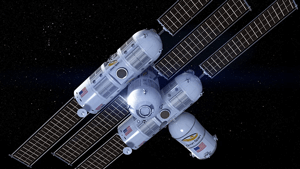
Orion Span was founded in 2017 by Frank Bunger and David Jarvis (CTO) Orion Span's HQ is in Houston, Texas. The company announced in March 2018 that it was building a commercial space station.
Aurora Space Station
Aurora Station is a planned space station habitat intended for commercial and scientific payloads. Aurora is billed to be the first fully modular space station. With berths for six people at a time it will allow two crew and four passengers a 12-day space travel tour. The cost of a flight to the Aurora station is pegged at $9.5 million dollars per seat.
